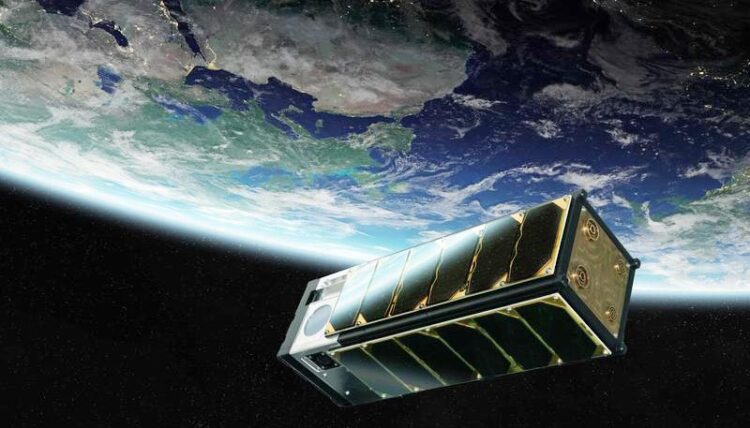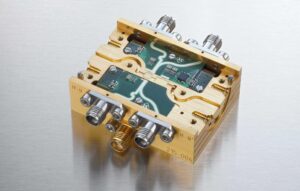W-band receive module

The W-band receive module is intended to enable low-noise data transmission in satellite communications in the future—such as in the W-Cube nanosatellite shown here.
(c) Fraunhofer IAF
… for ultra-low noise data transmission in satellite communications.
To meet the world’s rapidly growing data consumption and increasing bandwidth requirements, satellite communications are shifting to higher frequencies. The W-band (75–110 GHz) is well suited for use in space, but technical components have been lacking so far.
For this reason, Fraunhofer IAF has launched the BEACON project: Together with researchers from RPG-Radiometer Physics, a novel W-band receive front-end module is to be realized as part of the ESA ARTES program. The goal is to develop a technology that is lower in noise than any previous W-band amplifier module and thus enables the transfer of extremely high data rates through space.

(c) Fraunhofer IAF
Due to limited bandwidth, it is becoming increasingly difficult to meet the growing need for higher data rates in satellite systems with very high data throughput. Using higher frequencies can help to meet this increasing demand. The W-band (75–110 GHz) is well suited for satellite communication applications: Not only does it offer high data throughput when used at high altitudes and in space, but it is also likely to significantly increase system capacity, reduce the number of gateway earth stations, and thus reduce overall system costs. However, there has been a lack of suitable technology and hardware for applications in the W-band frequency range to date.
The Fraunhofer Institute for Applied Solid State Physics IAF, together with RPG Radiometer Physics GmbH, has taken up this challenge in the project “BEACON—W-band Integrated Active Receive Front-End”: The project partners are developing an integrated active W-band receive frond-end with an operating frequency of 81 to 86 GHz that will enable extremely high data rates or long-distance data transmission with low power consumption.
Minimal noise at high data throughput
The receive module is based on Fraunhofer IAF’s extremely low-noise MMIC technology (MMIC—monolithic microwave integrated circuit). “Fraunhofer IAF has done tremendous development work in the mHEMT process over the past years and has acquired a core competence in developing amplifiers with the lowest noise worldwide. Based on this, the project aims to reduce the noise figure to below 3.5 dB and thus significantly improve the state of the art,” explains Dr. Philipp Neininger, project coordinator and researcher at Fraunhofer IAF.
In addition, the receive module is designed to isolate left- from right-hand circular polarization and amplify them with two separate channels (LHCP and RHCP), which serves to effectively double data throughput.
A major challenge in the BEACON project is the novel arrangement of components on the very small module area. The new approach involves integrating a large number of functions within a very small footprint: These include the polarizer, waveguide transitions to two individual amplifiers, two coaxial output connectors and the associated DC circuitry. “The combination of these features—extremely low noise, two different polarizations and an innovative array—brings an enormous technological advance in the field of W-band components,” Neininger summarizes the project proposal.
W-band data transmission from space already successfully tested
Only last year, satellite signals in the W-band frequency range were received from space for the first time. The W-Cube nanosatellite began its journey to polar orbit aboard a Falcon 9 rocket in the summer of 2021 and has since been successfully transmitting satellite signals to Earth at 75 GHz from an altitude of 500 kilometers. For this mission, Fraunhofer IAF had already developed the transmitter module of the satellite as well as the receive module of the corresponding ground station.
Link to the press release from September 6, 2021: https://www.iaf.fraunhofer.de/en/media-library/press-releases/satellite-transmit…
Weitere Informationen:
https://www.iaf.fraunhofer.de/en/media-library/press-releases/beacon-project.htm…
Media Contact
All latest news from the category: Physics and Astronomy
This area deals with the fundamental laws and building blocks of nature and how they interact, the properties and the behavior of matter, and research into space and time and their structures.
innovations-report provides in-depth reports and articles on subjects such as astrophysics, laser technologies, nuclear, quantum, particle and solid-state physics, nanotechnologies, planetary research and findings (Mars, Venus) and developments related to the Hubble Telescope.
Newest articles

Innovative 3D printed scaffolds offer new hope for bone healing
Researchers at the Institute for Bioengineering of Catalonia have developed novel 3D printed PLA-CaP scaffolds that promote blood vessel formation, ensuring better healing and regeneration of bone tissue. Bone is…

The surprising role of gut infection in Alzheimer’s disease
ASU- and Banner Alzheimer’s Institute-led study implicates link between a common virus and the disease, which travels from the gut to the brain and may be a target for antiviral…

Molecular gardening: New enzymes discovered for protein modification pruning
How deubiquitinases USP53 and USP54 cleave long polyubiquitin chains and how the former is linked to liver disease in children. Deubiquitinases (DUBs) are enzymes used by cells to trim protein…


